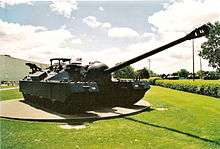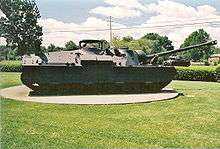T28 Super Heavy Tank
| T95 Gun Motor Carriage | |
|---|---|
| Type | Tank destroyer/Super-heavy tank |
| Place of origin | United States |
| Service history | |
| Used by | United States |
| Production history | |
| Manufacturer | Pacific Car and Foundry |
| Produced | 1945 |
| No. built | 2 |
| Specifications | |
| Weight | 95 short tons (86.2 metric tons) |
| Length | 36 ft 6 in (11.1 m) |
| Width | 14 ft 11 in (4.39 m) |
| Height | 9 ft 4 in (2.84 m) |
| Crew | 4[1][2] |
|
| |
| Armor | 12 in (305 mm) |
Main armament | 105 mm T5E1 gun, with 62 rounds |
Secondary armament | .50 cal (12.7 mm) Browning heavy machine gun, with 660 rounds |
| Engine |
Ford GAF V-8 gasoline 500 hp (372 kW)[1] |
| Power/weight | 5.8 hp/tonne |
| Suspension | double tracks, horizontal volute spring |
Operational range | 100 miles (160 km) |
| Speed | 8 mph (13 km/h)[2] |
The T28 Super Heavy Tank was an American heavily armored tank self-propelled gun designed for the United States Army during World War II. It was originally designed to be used to break through German defenses of the Siegfried Line, and was later considered as a possible participant in the planned invasion of the Japanese mainland.
The 100-ton vehicle was initially designated a heavy tank. It was re-designated as the 105 mm Gun Motor Carriage T95 in 1945, and then renamed in 1946 as the Super Heavy Tank T28.
Only two prototypes were built before the project was terminated. It was the heaviest tank the United States has ever manufactured.[3]
Name
Initially named Heavy Tank T28 when construction was authorized in 1944, the design did not fit in the usual categories of vehicles leading to reclassification.[4] As it did not have its armament in a revolving turret, Ordnance requested a name change to 105 mm Gun Motor Carriage T95, the change becoming official in March 1945.[5] However, due to its heavy armor and armament — while self-propelled guns in United States service were lightly armored — it was renamed Super Heavy Tank T28 in June 1946 by OCM 37058.[6]
Development
The T28/T95 was designed to be used for attacking the heavy defenses expected of the German Siegfried Line.[3] The 105mm T5E1 gun selected was known to have very good performance against concrete and "expected to be extremely effective at reducing heavy fortifications"[4] After the vehicle passed trials, the German Siegfried Line had already been infiltrated and overwhelmed by the allied forces, so the designers decided to have the T28/T95 tanks to fight on the Japanese mainland later in the war. The Atom bombs (Little Boy and Fat Man) dropped on Nagasaki and Hiroshima ended the Pacific conflict in Japan before the tank was able to be transported overseas.
The need for an assault tank was first identified in 1943, Ordnance proposing that 25 vehicles could be ready for operations. A conference in March 1944 between Ordnance Department and Army Ground Forces resulted in agreement to build five. The Pacific Car and Foundry Company were supplied with the design in March 1945, completed final design and had the first hull welded by August.[7] By the time the first tank was completed and ready for combat, the war was over.[1] The plan for five was reduced to two.
As it did not have a turret, but a fixed casemate mount instead for its main armament, and the 105 mm gun fitted could only elevate from 19.5° to -5° and traverse from 10° right to 11° left of the centerline, the T28/T95 more closely resembled a self-propelled gun, and was redesignated as "T95 Gun Motor Carriage" in 1945, but in June 1946, the vehicle was redesignated again as "Super Heavy Tank T28".[3]
Two prototypes of the T28 were built. They underwent evaluation at the Aberdeen Proving Ground and Fort Knox facilities until 1947. In 1947 one of the T28s was heavily damaged by an engine fire during trials at Yuma Proving Ground and was broken up and sold for scrap. The T28 never went into service due to the obsolete design, expensive maintenance costs, and the heavy weight; prevented it from being transported across seas, but was retained to test the "durability of components on such a heavy vehicle". Work on it ended before completion as the War Department decided to stop the development of vehicles of that sort of weight[8] and the T28 program terminated in October 1947. By that point the T29 and T30 turreted heavy tank designs had been built.[3] The T29 mounted the same gun as the T28 in a conventional rotating turret. The T30 was developed with a larger-caliber gun and more powerful engine.[3] The T29 program was used to test mechanical components for future tank designs[9]
Surviving vehicle
In 1974 the last prototype was discovered abandoned in a field at Fort Belvoir, Virginia. It is unknown where it spent the intervening 27 years. It is the sole remaining example of these tanks and was exhibited at the Patton Museum of Cavalry and Armor in Kentucky.[1][10] In 2011, it was shipped to its new home at Fort Benning, Georgia. It will be placed in the new Patton Park, which is a plot of 30 acres where all of the tanks being stored at Fort Benning will be displayed. Patton Park will be completed by 2020.[11] Unfortunately the vehicle was damaged in January 2017 during transit to another facility for external refurbishment when it broke loose from the M1070 HET carrying it. The transporter failed to negotiate a downhill slope and subsequent bend at a safe speed, causing the securing chains to break and allowing the T28 to slide off the trailer. Despite then rolling into a ditch, only minor repairable damage was sustained to 2 bogies. The outer track units had been removed.[12]
Design


The mechanical superstructure was taken from a T23.[2] The original plan was to build five prototype vehicles, with a production total of 25. Its total weight when fully equipped would have reached 95 short tons (86 tonnes).[1] To lower ground pressure, instead of two tracks, it used four tracks that projected forward of the hull, each 12.9 inches (328 mm) wide.[3] The outer tracks could be detached within two hours for rail transport: After removal, they could be fixed together to make a unit that could be towed behind the tank.[6] Due to its extreme weight and low engine power, the T28 had extremely limited obstacle-crossing ability and could not cross any of the portable bridges available at the time, and so was considered impractical in the field and not suitable for production.
The T28 had no conventional turret, with a casemate style hull instead, giving it a comparatively low profile, as the later examples of the fully enclosed Jagdpanzer-family of German tank destroyers, not entirely dissimilar to the 50 short-ton weight German Jagdpanther. Its main armament was a 105 mm T5E1 gun, in a ball-shaped gun mantlet set into the vertical hull front.[1][2] The traverse was limited to 10° right and 11° left, and elevation from 19.5° to −5°. When traveling, the gun was locked at the maximum elevation.[3] The only other armament was a .50 cal. (12.7 mm) M2 Browning machine gun on a ring mount above the commander's hatch for anti-aircraft use.[1][13] The main gun — 65 calibres long — had a muzzle velocity of 3,700 feet per second (1,130 m/s), with a range of up to 12 miles (19 km).[1][14]
The armor was very thick compared to other tanks of the time, up to 12 inches (305 mm) thick on the front. This was considered heavy enough to provide protection from the German 88 mm gun used as tank gun and anti-tank guns.[3] The lower hull front had 5.25 in (130 mm) of armor, and the sides 2.5 in (64 mm). The suspension system and lower hull were covered with 4-in (100 mm) thick steel skirts.[3] The engine was a gasoline-powered Ford GAF V-8, delivering 500 hp,[1] at 2600 rpm though the Torqmatic transmission, which left the vehicle underpowered, geared down to a top speed of about 8 mph (13 km/h) and greatly limited its obstacle-climbing capability.[3][15]
See also
- List of U.S. military vehicles by model number
- Tank classification
- Jagdtiger — a comparable German vehicle for anti-tank use. Entered limited production.
- Tortoise heavy assault tank — a comparable British vehicle for attacking fortifications; only six built.
Notes
- 1 2 3 4 5 6 7 8 9 "United States — Heavy Tanks". Retrieved 1 October 2008.
- 1 2 3 4 Foss, Christopher. The Encyclopedia of Tanks and Armoured Fighting Vehicles. Spellmount. ISBN 1-86227-188-7. Retrieved October 2008. Check date values in:
|access-date=(help) - 1 2 3 4 5 6 7 8 9 10 Thomas M. Tencza (2000). "Article 1: Americas’s Super Heavy Tank". Battle Tanks. Retrieved 2 October 2008.
- 1 2 Hunnicutt p61
- ↑ Hunnicutt p62
- 1 2 Hunnicutt p65
- ↑ Hunnicutt p61-2
- ↑ Hunnicutt p65-66
- ↑ Hunnicutt p74
- ↑ Patton Museum List of Exhibits
- ↑ http://www.army.mil/article/109642/Pattons__Park_to_display_9_vehicles/
- ↑ "National Armor and Cavalry Museum". www.facebook.com. Retrieved 2017-04-07.
- ↑ Hunnicutt p196
- ↑ Hunnicutt p69
- ↑ Hunnicutt p64
- Hunnicutt R. P., Firepower: A History of the American Heavy Tank. Presidio.
External links
| Wikimedia Commons has media related to T28 Super Heavy Tank. |
- "This Lumbering Monster Is Newest Antique", January 1946, Popular Science
- T28 Super Heavy Tank (Gun Motor Carriage T95) Self-Propelled Gun / Heavy Tank (1945)